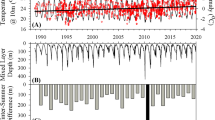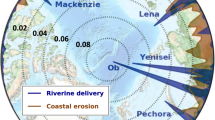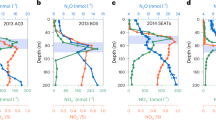Abstract
The eastern equatorial Pacific Ocean is the site of approximately 20–50% of new biological production in the global oceans1. This region is also responsible for the greatest efflux of CO2 from oceans to the atmosphere2. New production, which fixes carbon in response to external inputs of nutrients as opposed to supply from local nutrient recycling, is thought to modulate the CO2 release3. But what controls new production in this region is less clear. Here we present a quantitative reconstruction of biological production in the surface ocean for this region over the past 130,000 years, which shows that the equatorial Pacific Ocean exhibits higher-frequency variations than the South Equatorial Current. Comparison of these records with palaeotemperature reconstructions indicates that atmospherically driven mechanisms—such as aeolian flux of iron or wind-driven changes in upwelling rate of nutrient-rich waters—are unlikely to have influenced longer-term rates of production in this region. Instead, biological production appears to be governed by changes in ocean circulation and the chemical composition of upwelled water.
This is a preview of subscription content, access via your institution
Access options
Subscribe to this journal
Receive 51 print issues and online access
$199.00 per year
only $3.90 per issue
Buy this article
- Purchase on Springer Link
- Instant access to full article PDF
Prices may be subject to local taxes which are calculated during checkout


Similar content being viewed by others
References
Barber, R. & Chavez, R. Regulation of primary productivity rate in the equatorial Pacific. Limnol. Oceanogr. 36 , 1803–1815 (1991).
Tans, P., Fung, I. & Takahashi, T. Observational constraints on the global atmosphere CO 2 budget. Science 247, 1431– 1438 (1990).
Murray, J., Barber, R., Roman, M., Bacon, M. & Feely, R. Physical and biological controls on the carbon cycling in the equatorial Pacific. Science 266, 58–65 (1994).
Toggweiler, J., Dixon, D. & Broecker, W. The Peru upwelling and the ventilation of the South Pacific thermocline. J. Geophys. Res. 96, 20467–20497 (1991).
Pisias, N., Mix, A. & Zahn, R. Non-linear response in the global climate system: evidence from benthic oxygen isotope record in core RC13-110. Paleoceanography 5 , 147–160 (1990).
Mix, A. & Shackleton, N. Benthic foraminiferal stable isotope stratigraphy of site 846: 0-1.8 M.A. Proc. ODP Sci. Res. 138, 839–854 ( 1995).
Ninkovitch, D. & Shackleton, N. Distribution, stratigraphic position and age of ash layer ‘L’ in the Panama Basin region. Earth Planet. Sci. Lett. 27, 20–34 (1975).
Loubere, P. & Fariduddin, M. Quantitative estimation of global patterns of surface ocean biological productivity and its seasonal variation on timescales from centuries to millennia. Glob. Biogeochem. Cycles 13, 115–133 ( 1999).
Lampitt, R. & Antia, A. Particle flux in the deep seas: regional characteristics and temporal variability. Deep Sea Res. 44, 1377–1403 (1997).
Loubere, P. The surface ocean productivity and bottom water oxygen signals in deep water benthic foraminiferal assemblages. Mar. Micropaleontol. 28, 247–262 (1996).
Fariduddin, M. & Loubere, P. The surface ocean productivity response of deeper water benthic foraminifera in the Atlantic Ocean. Mar. Micropaleontol. 32, 289– 310 (1997).
Loubere, P. A multiproxy reconstruction of biological productivity and oceanography in the eastern equatorial Pacific for the past 30,000 years. Mar. Micropaleontol. 37, 173–198 (1999).
Lyle, M. et al. The record of Late Pleistocene biogenic sedimentation in the eastern tropical Pacific Ocean. Paleoceanography. 3 , 39–59 (1988).
Pisias, N. & Mix, A. Spatial and temporal oceanographic variability of the eastern equatorial Pacific during the late Pleistocene: evidence from radiolarian microfossils. Paleoceanography 12, 381–394 (1997).
Martin, J. Glacial-interglacial CO2 change: the iron hypothesis. Paleoceanography 5, 1–13 (1990).
Kutzbach, J. et al. Climate and biome simulations for the past 21,000 years. Quat. Sci. Rev. 17, 473–506 (1998).
Rea, D. The paleoclimatic record provided by aeolian deposition in the deep sea: the geologic history of wind. Rev. Geophys. 32, 159– 195 (1994).
Mix, A. & Morey, A. in The South Atlantic: Present and Past Circulation (eds Wefer, G. et al.) 503– 525 (Springer, Berlin, 1996).
Liu, Z. et al. Dynamic and observational constraints on the tropical Pacific Ocean at the last glacial maximum. Geophys. Res. Lett. 27 , 105–108 (2000).
Francois, R. et al. Contribution of Southern Ocean surface water stratification to low atmospheric CO2 concentrations during the last glacial period. Nature 389, 929–935 (1997).
Toggweiler, J. & Carson, S. in Upwelling in the Ocean: Modern Processes and Ancient Records (eds Summerhayes, C. et al.) 337–359 (Wiley and Sons, New York, 1995).
Barber, R. et al. Primary productivity and its regulation in the equatorial Pacific during and following the 1991–1992 El Nino. Deep Sea Res. II 43, 933–969 (1996).
Fitzwater, S., Coale, K., Gordon, R., Johnson, K. & Ondrusek, M. Iron deficiency and phytoplankton growth in the equatorial Pacific. Deep Sea Res. II 43, 995– 1015 (1996).
Farrell, J., Pedersen, T., Calvert, S. & Nielsen, B. Glacial-interglacial changes in nutrient utilization in the equatorial Pacific Ocean. Nature 377, 514– 517 (1995).
Dugdale, R. & Wilkerson, F. Silicate regulation of new production in the equatorial Pacific upwelling. Nature 391, 270–273 (1998).
Berger, W. & Lange, C. Silica depletion in the thermocline of the glacial North Pacific: corollaries and implications. Deep Sea Res. II 45, 1885–1904 (1998).
Loubere, P. Quantitative estimation of surface ocean productivity and bottom water oxygen concentration using benthic foraminifera. Paleoceanography 9, 723–737 (1994).
Loubere, P. The impact of seasonality on the benthos as reflected in the assemblages of deep-sea foraminifera. Deep Sea Res. I 45, 409–432 (1998).
Berger, W. in Productivity of the Ocean: Present and Past (eds Berger, W., Smetacek, V. & Wefer, G.) 429–455 (Wiley, New York, 1989).
Antoine, D., Jean-Michel, A. & Morel, A. Oceanic primary production. 2. Estimation at global scale from satellite (coastal zone color scanner) chlorophyll. Glob. Biogeochem. Cycles 10, 57–69 (1996).
Acknowledgements
We thank M. Fariduddin and Q. Hui for helping to generate the benthic count data. This work was supported by the NSF.
Author information
Authors and Affiliations
Corresponding author
Rights and permissions
About this article
Cite this article
Loubere, P. Marine control of biological production in the eastern equatorial Pacific Ocean. Nature 406, 497–500 (2000). https://doi.org/10.1038/35020041
Received:
Accepted:
Published:
Issue Date:
DOI: https://doi.org/10.1038/35020041
This article is cited by
-
Repeated storage of respired carbon in the equatorial Pacific Ocean over the last three glacial cycles
Nature Communications (2017)
-
No iron fertilization in the equatorial Pacific Ocean during the last ice age
Nature (2016)
-
Evidence against dust-mediated control of glacial–interglacial changes in atmospheric CO2
Nature (2001)
-
Iron uncertainty
Nature (2000)
Comments
By submitting a comment you agree to abide by our Terms and Community Guidelines. If you find something abusive or that does not comply with our terms or guidelines please flag it as inappropriate.



